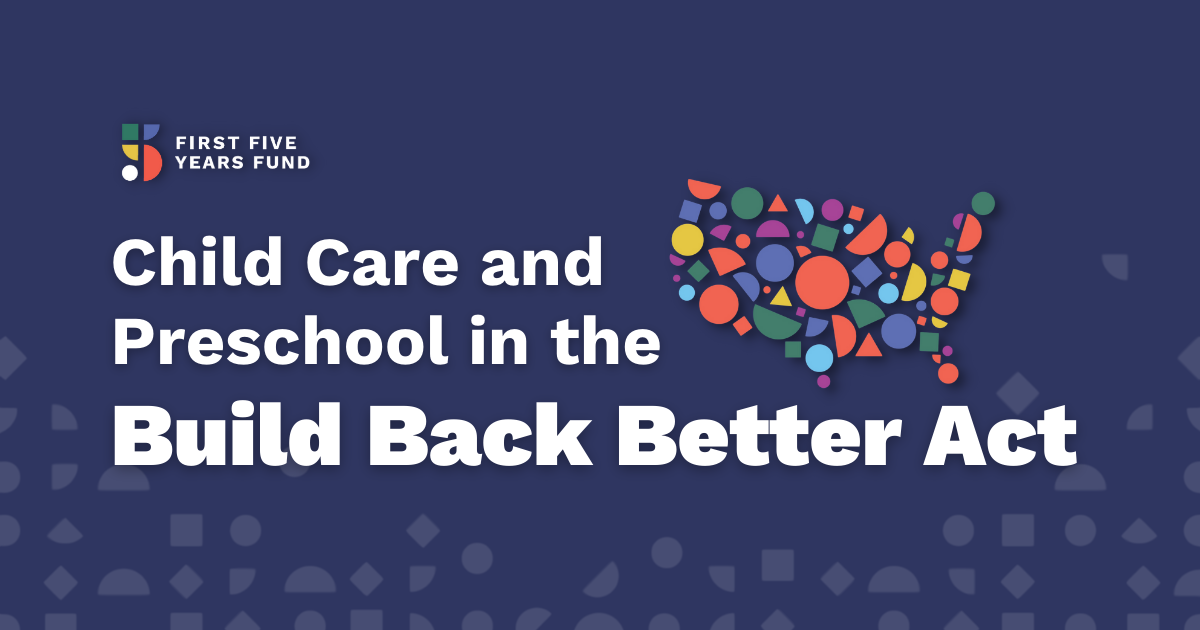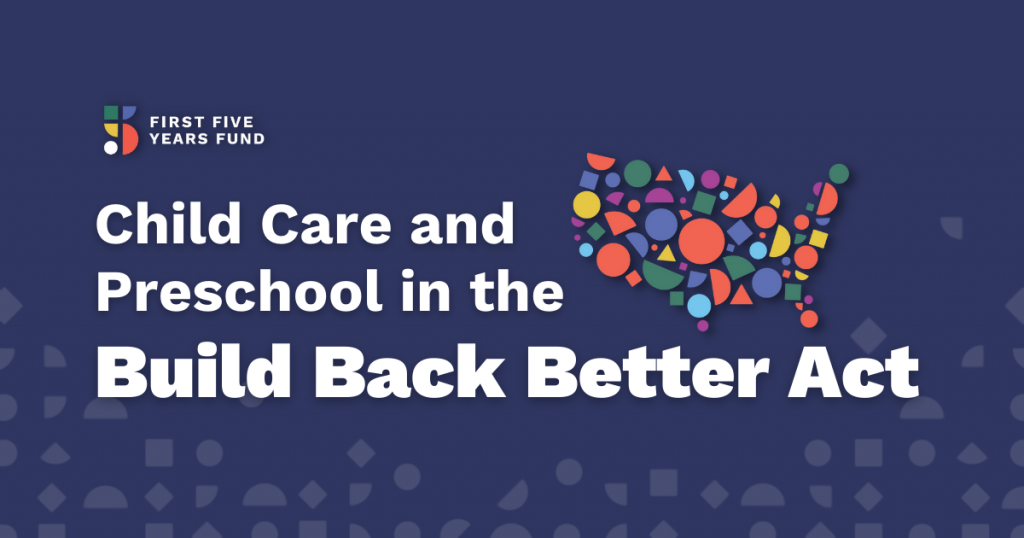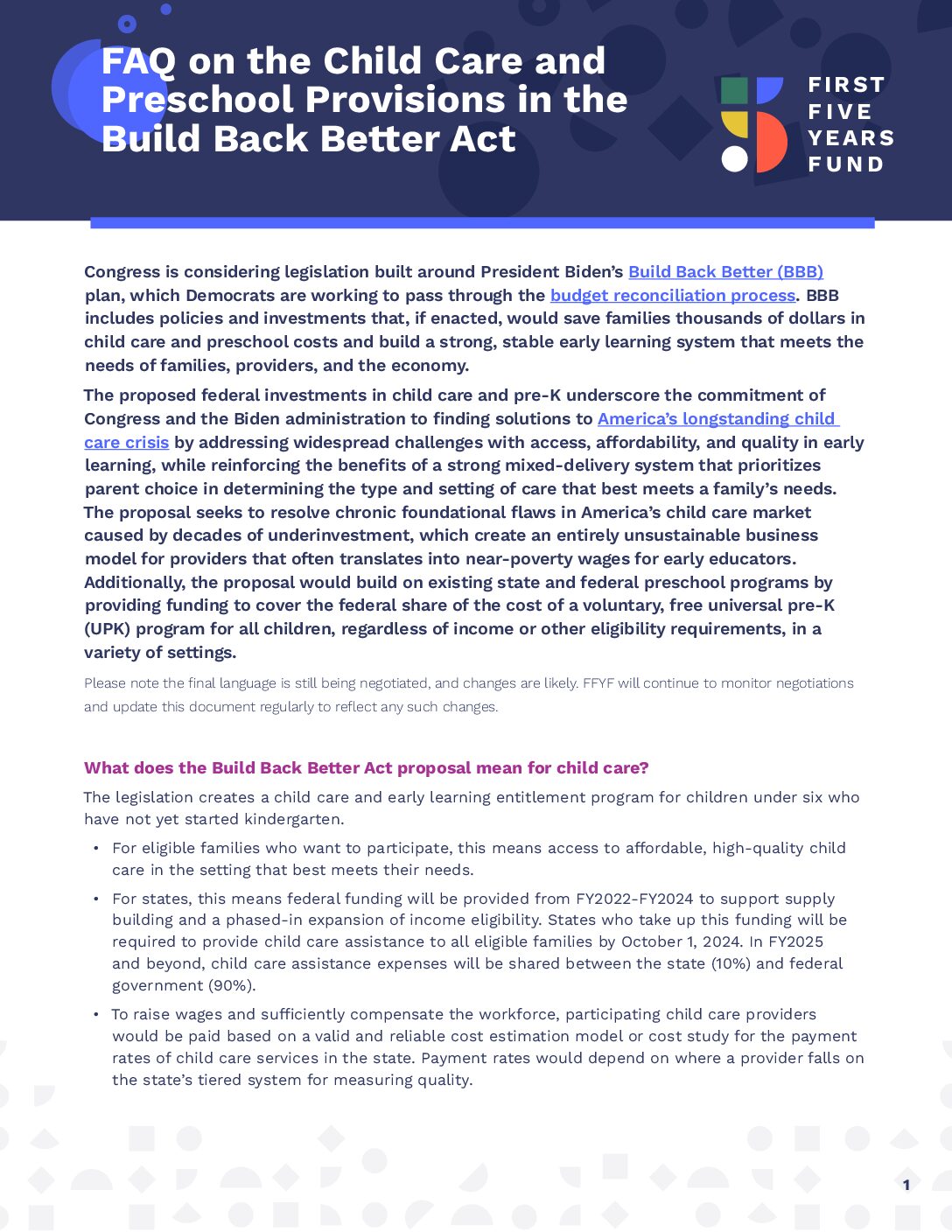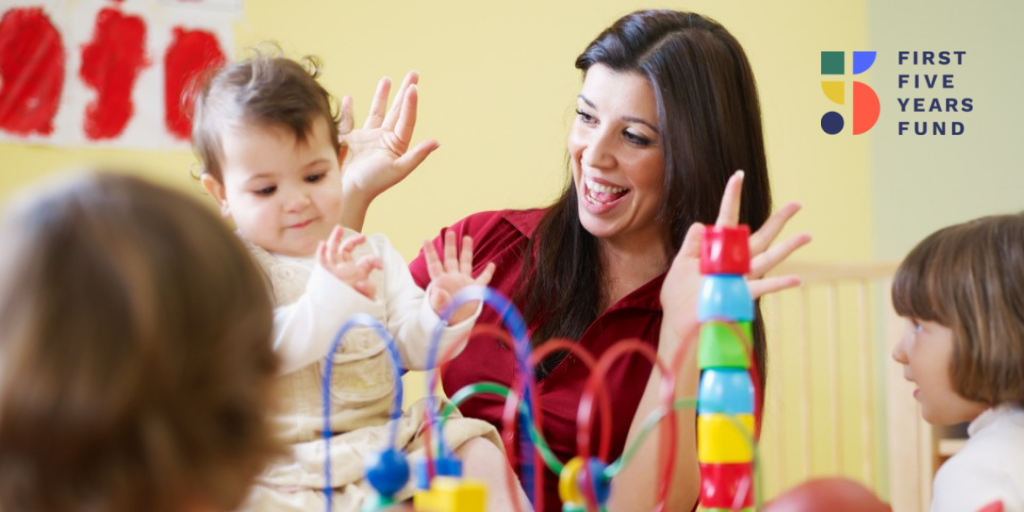FAQ on the Child Care and Preschool Provisions in the Build Back Better Act

Congress is considering legislation built around President Biden’s Build Back Better (BBB) plan, which Democrats are working to pass through the budget reconciliation process. BBB includes policies and investments that, if enacted, would save families thousands of dollars in child care and preschool costs and build a strong, stable early learning system that meets the needs of families, providers, and the economy.
The proposed federal investments in child care and pre-K, underscore the commitment of Congress and the Biden administration to finding solutions to America’s longstanding child care crisis by addressing widespread challenges with access, affordability, and quality in early learning, while reinforcing the benefits of a strong mixed-delivery system that prioritizes parent choice in determining the type and setting of care that best meets a family’s needs. The proposal seeks to resolve chronic foundational flaws in America’s child care market caused by decades of underinvestment, which create an entirely unsustainable business model for providers that often translates into near-poverty wages for early educators.
Additionally, the proposal would build on existing state and federal preschool programs by providing funding to cover the federal share of the cost of a voluntary, free universal pre-K (UPK) program for all children, regardless of income or other eligibility requirements, in a variety of settings.
Please note the final language is still being negotiated, and changes are likely. FFYF will continue to monitor negotiations and update this document regularly to reflect any such changes.

What does the Build Back Better Act proposal mean for child care?
The legislation creates a child care and early learning entitlement program for children under six who have not yet started kindergarten.
- For eligible families who want to participate, this means access to affordable, high-quality child care in the setting that best meets their needs.
- For states, this means federal funding will be provided from FY2022-FY2024 to support supply building and a phased-in expansion of income eligibility. States who take up this funding will be required to provide child care assistance to all eligible families by October 1, 2024. In FY2025 and beyond, child care assistance expenses will be shared between the state (10%) and federal government (90%).
- To raise wages and sufficiently compensate the workforce, participating child care providers would be paid based on a valid and reliable cost estimation model or cost study for the payment rates of child care services in the state. Payment rates would depend on where a provider falls on the state’s tiered system for measuring quality.
Which children and families will be eligible for child care?
- During the 3-year phase in, eligibility would be limited to children in families with incomes at or below a specified level: 100% of state median income (SMI) in FY2022, 125% of SMI in FY2023, and 150% of SMI in FY2024. Family copayments would vary by income.
- SMI is the income amount that divides a population into two equal groups: half having an income above that amount and half having an income below that amount.
- Using SMI to calculate income eligibility and copayments, rather than the federal poverty line, helps to take into account the differences in cost of living from state to state.
- For example, in the first year, a family of 4 in Arizona making $82,227 a year (100% SMI) would pay no more than $1,645 a year for child care, while a family of 4 in New Mexico making $67,949 a year (100% SMI) would pay no more than $1,359 a year.
- States who have appropriately prioritized assistance for direct child care services based on income can use funds provided in FY 2022, 2023, or 2024 to serve children whose family income exceeds the current maximum SMI (up to 250% SMI), with the Secretary’s approval.
- After the 3-year phase in, eligibility would be expanded to include families up to 250% SMI.
- To be eligible, a child must have one parent or legal caregiver who is working or participating in another eligible activity (e.g., job search, job training, educational program, health treatment for a work-limiting condition, or family leave).
- Exceptions to the parental activity requirement would be made for certain vulnerable children (including foster children and children experiencing homelessness) and for children with a parent over age 65.
- Once deemed eligible, a child would be considered eligible for 12 months.
How will the federal child care funds be distributed? Is there a state match?
Over the first 3 years, a total of $100 billion will be provided ($24 billion in FY2022, $34 billion in FY2023, and $42 billion in FY2024). The new child care and early learning entitlement program provides high-quality, affordable child care for children ages birth to five, increases wages for the early childhood workforce, and invests in child care quality and supply (including facilities). In FY2022-FY2024, participating states would receive an allotment based on the Child Care and Development Block Grant (CCDBG) Act. There is no required state match in the first 3 years. Of the total funding amount, specific amounts are designated for certain purposes as follows:
- 50% of funds on direct child care services for eligible children;
- 25% of the funds on activities to improve the quality and supply of child care services;
- 25% of the funds on direct child care services,supply and quality building, or administration.
After the initial 3 years, in FY2025-FY2027, states receive reimbursement from the federal government for:
- Child care assistance. Child care assistance covers the grants, contracts, and certificates needed to cover the full cost of providing high-quality child care, reflecting a capped family contribution. States cover 10% of these costs, and the federal government covers 90% of these costs.
- Quality and supply activities. While some costs of high-quality child care will now be covered under direct assistance, states must spend between 5-10% of their total program expenses on quality and supply activities. The federal government will cover these costs using the federal medical assistance percentage (FMAP) rate.
- Administration expenses. The federal government and states will each pay 50%.
Separate from match requirements, in all years states would have to meet a maintenance-of-effort (MOE) requirement based on an average of state spending on child care in the preceding three fiscal years. This spending can be counted in meeting state match requirements, however.
With so many families living in child care deserts, how will the bill ensure an adequate supply of child care?
Over the first 3 years, 25% of the funding states receive is dedicated to activities that improve the quality and supply of child care services and 25% to direct child care services, supply and quality building, or administration. In FY2025-2027, states must reserve between 5 and 10% of total funds for activities that increase the quality and supply of eligible child care providers.
These activities include startup and supply expansion grants for child care providers, with priority given to those providing or seeking to provide child care in underserved communities and for underserved populations. Funds could be used to support startup and expansion costs and to assist in meeting health and safety requirements, achieving licensure, and meeting requirements in the state’s tiered system for measuring quality. Further, transitional and full state plans must specify how funds will be used to increase the supply of child care and demonstrate how the state will prioritize expanding access to care for underserved populations and in underserved areas.
Can faith-based providers participate
The bill specifies that child care certificates may be used for sectarian child care services if freely chosen by the parent. The bill also specifies that child care certificates shall be considered “indirect federal financial assistance” to the provider. As outlined in federal regulations, faith-based organizations are eligible on the same basis as any other organization to participate in any HHS awarding agency program or service for which they are otherwise eligible. For example, faith-based programs currently participate in CCDBG, which serves children from low-income families or who meet other eligibility requirements. Recipients of “indirect federal financial assistance” are not subject to requirements of “direct federal financial assistance” that asserts explicitly religious activities be separate, in time or location.
What must states do to implement the new child care program if they opt in?
Within three years of receiving funds, states must:
- Raise payment rates to meet the cost of care, including, at a minimum, providing a living wage and establishing wages equivalent to elementary educators with equivalent credentials;
- Create a tiered system to measure the quality of child care providers and help providers to reach higher quality standards (highest tier standards would be at least equivalent to Head Start Program Performance Standards (HSPPS)); and
- Demonstrate that they have consulted or will consult with organizations representing child care directors, teachers, or other staff; early childhood education and development experts; and families to implement licensing standards and a pathway to licensure available to and appropriate for providers in a variety of settings.
States’ plans must also:
- Prohibit child care providers from charging families more than the required copay;
- Assure assistance to children for not less than 12 months; and
- Demonstrate that they will prioritize increasing access to and the quality and supply of child care for underserved populations, including at a minimum, low-income children, children in underserved areas, infants and toddlers, children with disabilities and infants and toddlers with disabilities, children who are dual language learners, and children experiencing homelessness, children in foster or kinship care, children who receive care during nontraditional hours, and vulnerable children as defined by the lead agency.
What are the Head Start Program Performance Standards (HSPPS)?
HSPPS define standards and minimum requirements for all Head Start services. These standards:
- Apply to both Head Start and Early Head Start programs;
- Serve as the foundation for Head Start’s mission to deliver comprehensive, high-quality individualized services supporting the school readiness of children from low-income families;
- Reflect best practices and the latest research on early childhood development and brain science; and
- Give grantees flexibility in achieving positive child and family outcomes and encourage the use of data to track progress and reach goals in all program areas.
Is child care for school-aged children included in this proposal?
No. The program is intended for children from birth through age five who are not yet in kindergarten. Families with No. The program is intended for children from birth through age five who are not yet in kindergarten. Families with school-aged children may see expanded options available through CCDBG, as that program will shift focus from early learning once the new entitlement is in place.
What happens to the current CCDBG funding?
- States will continue receiving CCDBG funding.
- For states who opt in to the child care proposal, spending on care for children under 6 would be limited to 10% of CCDBG, including, for example, relative and family, friend, and neighbor providers who are not part of the licensed system, thus increasing to 90% the amount being used to assist with out-of-school time care for children ages 6-13. (Currently, 34% of CCDBG subsidies help pay for school-aged care.)
- For states that choose not to opt in to the child care proposal, they will continue to receive CCDBG funding as they do today with no changes.
- CCDBG remains otherwise unchanged and available for those system-supporting purposes in current law.
How will the BBB expand access to Pre-K in states that opt in?
The Build Back Better Act would create a high-quality, free, inclusive, and mixed-delivery preschool program available to all three- and four-year-old children on a voluntary basis.
- 44 states and the District of Columbia fund pre-K programs, however, in the 2019-20 school year, these programs enrolled just 34% of 4-year-olds and 6% of 3-year-olds.
- States have struggled to fund pre-K programs, particularly when faced with declining state revenue, and already rely on federal funding to serve preschool-aged children, particularly children from low-income families and children with disabilities or developmental delays.
- The proposal would build on existing state and federal preschool programs by providing funding to cover the federal share of the cost of a universal pre-K (UPK) program for all children, regardless of income or other eligibility requirements. Additionally, states must ensure the preschool program does not disrupt the stability of infant and toddler care throughout the state.
How would UPK be funded?
- The proposal includes $4 billion in FY2022, $6 billion in FY2023, $8 billion in FY2024, and such sums as may be necessary in FY2025-FY2027 to provide the federal share of the cost of universal, high-quality, free, inclusive, and mixed delivery preschool services.
- To increase the quality and supply of child care services, in FY2022-FY2024, there would be no state match required for spending on the costs of preschool services.
- Starting in FY2025, states (including the District of Columbia) must contribute a 10% match, in cash or in kind. The required state match would increase to 25% in FY2026 and to 40% in FY2027.
- Spending on state activities (administration of the preschool program, supporting continuous quality improvement, outreach and enrollment support, data systems building, supporting staff degree and credential attainment, ensuring access to children with disabilities, transportation, and updating needs assessment) must be matched at 50% in each year (FY2025-FY2027). The maximum match for state activities would be capped at 5% of expenditures for preschool services.
- Federal funds must supplement, not supplant, other federal, state, and local funds for early childhood care and education programs. Thus a state must maintain its investment in any existing publicly-funded preschool programs or state-funded Head Start programs. If a state reduces per child spending, the Department of Health and Human Services (HHS) (in collaboration with the Department of Education (ED)) may correspondingly reduce federal funds.
Is the UPK proposal a school-based system?
- No. The legislation requires states to support a mixed-delivery system. This includes equitable distribution of preschool seats and resources among settings including Head Start, schools, and child care (including family child care).
- Eligible preschool providers include Head Start agencies or delegate agencies funded under the Head Start Act; local educational agencies (acting alone or with an educational service agency) that are licensed by the state or meet comparable health and safety standards; licensed child care providers (including center-based providers, family child care providers, and networks of family child care providers); or a consortium of such entities.
What are other requirements of the UPK program?
- Programs must be universally available, high-quality, free, and inclusive.
- Within 18 months of receiving funds, states must have in place state preschool education standards, which, at a minimum, are as rigorous as the school readiness section of HSPPS, include standards for class sizes and ratios, and use Head Start duration standards (at least 1,020 annual hours). Programs must meet these requirements within 1 year of receiving funding.
- States must also have policies for expedited enrollment for certain populations, and prioritize localities serving high-need communities.
- Subgrants or contracts with preschool providers will be for at least three years.
- State plans must provide assurances that it will provide salaries and set salary schedules for preschool staff that are equivalent to salaries of elementary school staff with similar credentials and experience and, at a minimum, provide a living wage for all staff of such providers.
Who would administer the new Child Care and UPK Programs?
- Funds for both programs would be appropriated to the U.S. Department of Health and Human Services (HHS).
- The UPK program would be administered by HHS in collaboration with the U.S. Department of Education (ED).
- At the state level, the child care program would be administered by a lead agency (state agency or joint interagency office), designated by the governor, pursuant to a plan approved by the Secretary of HHS.
- Similarly, the UPK program would be administered by a state lead agency (a state agency or joint interagency office), designated by the governor, pursuant to a plan approved by the Secretary of HHS.
Is Head Start included in the UPK proposal?
Yes. The UPK proposal specifies Head Start agencies are eligible providers, and states must describe how they will partner with Head Start agencies to ensure the full utilization of Head Start programs. Additionally, from amounts appropriated for UPK, the proposal designates $2.5 billion annually for FY2022-FY2027 to improve compensation for Head Start staff.
In states that opt out of funding, Head Start agencies may apply for both the child care and UPK grants to localities, and both proposals include funding for Head Start expansion grants (explained further below).
What will happen if a state “opts out” of either the child care or UPK program?
- Generally, things will remain unchanged as it pertains to child care subsidies and preschool at the state level. States would continue to receive mandatory and discretionary CCDBG funds.
- The proposal includes optional grants to localities in these states, including cities, counties, and Head Start grantees, with priority given to entities serving a high percentage of individuals from underserved populations. Funding for these grants is as follows:
- $4.75 billion in FY2022 (available until September 30, 2027) for Local Birth to Five Early Learning Grants.
- $9.5 billion in FY2022 (available until September 30, 2027) for UPK grants.
- The proposal also includes funding for grants to a Head Start agency in a state that has not received payments under either program to carry out the purposes of the Head Start Act. Funding for these grants is as follows:
- $14.25 billion in FY2022 (available until September 30, 2027) under the child care program.
- $9.5 billion in FY2022 (available until September 30, 2027) under the UPK program.
- The Secretary may reallot funds appropriated for FY2022-2024 from nonparticipating states and funds from participating states that are unobligated on October 1, 2024 to a participating state without unobligated funds or to an eligible locality or Head Start agency. The Secretary can also recoup any unused localities grants funding for Head Start expansion grants in nonparticipating states.
Are current providers included in the proposals for child care and UPK? What if they are not currently licensed?
Yes, current providers are included. Under the child care proposal:
- Providers who have been eligible under CCDBG will be deemed “eligible providers” for 3.5 years after their home state receives funding. Also, state plans must describe the timeline it will use to ensure sufficient time for these providers to comply with licensing standards.
- Current providers who have not been participating in CCDBG but who are licensed, participate in the state’s tiered system for measuring quality within four years of their state receiving funding, and meet a state’s CCDBG provider requirements would also be eligible.
- Within 2.5 years of receiving funds, states must create a pathway to appropriate licensure for providers who are not currently licensed.
Under the UPK proposal:
- States must provide assurances they will require educational qualifications for teachers including, at a minimum, requiring lead teachers to have a baccalaureate degree in early childhood education or a related field within six years of enactment.
- The degree requirement would not apply to individuals employed by an eligible child care provider or early education program for three of the last five years with necessary content knowledge and teaching skills as determined by the state.
Subscribe to FFYF First Look
Every morning, FFYF reports on the latest child care & early learning news from across the country. Subscribe and take 5 minutes to know what's happening in early childhood education.



